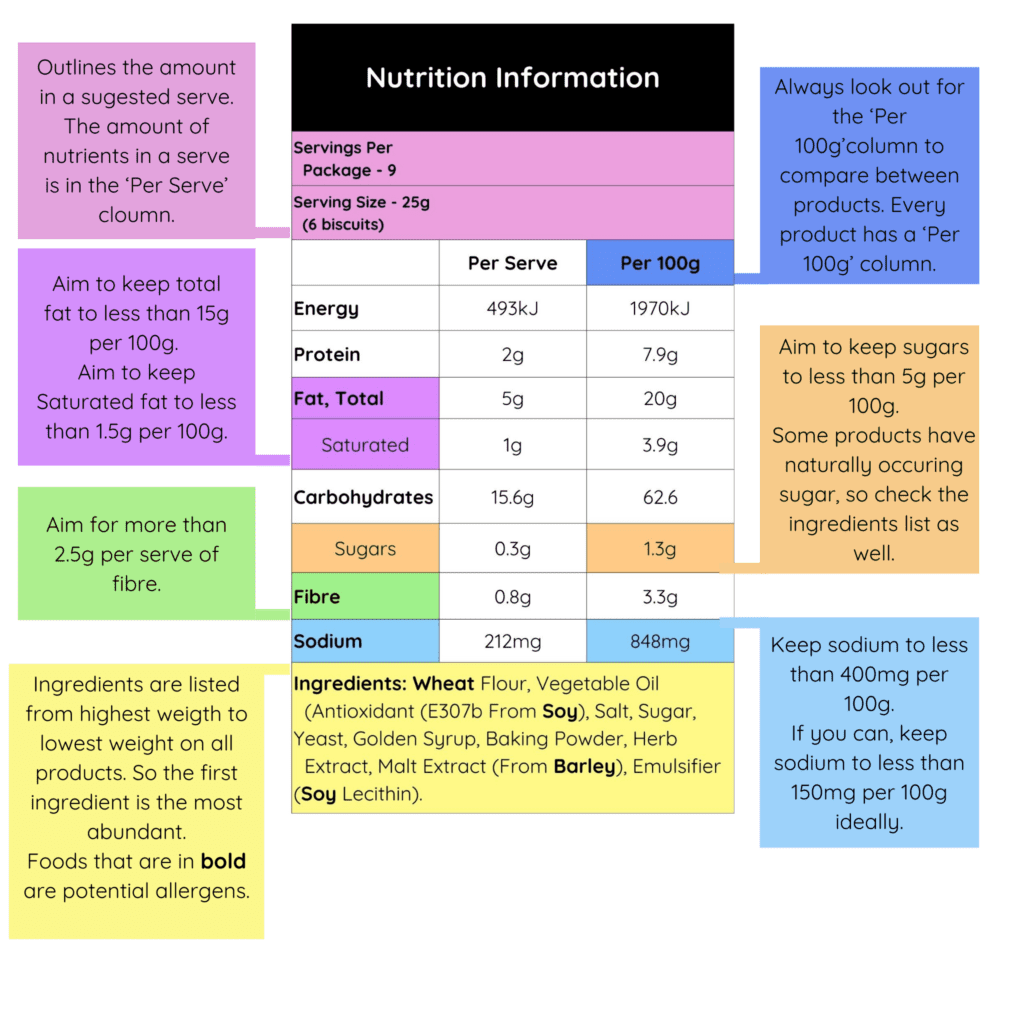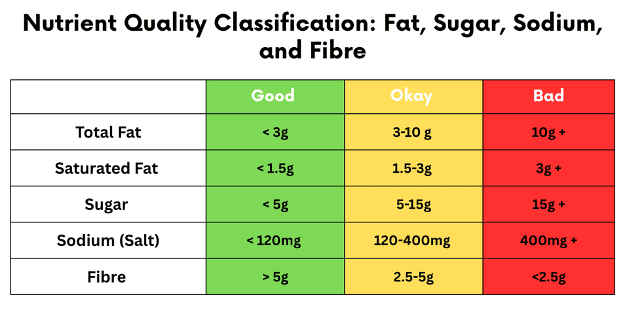Navigating grocery aisles can be challenging, particularly when striving to make healthier choices. This is why A Simple Guide to Nutrition Label Reading on Australian Food Products can be so helpful. As a dietitian with extensive experience analysing food labels and ingredient lists, I can’t tell you how many times I’ve stood in the cereal aisle, staring at row after row of granola, each brand making bold claims about being the healthiest, the most natural, or the most sustainable. What started as a simple grocery run has turned into something of an obsession. I mean, who knew picking out granola could turn into a full-blown investigation? The problem isn’t just the marketing; it’s the overload of information on every box. Nutritional labels are packed with so many numbers and percentages, it feels like deciphering a secret code. The amount of sugar, fibre, fat content, protein levels… it’s like a balancing act. And don’t even get me started on the long lists of ingredients, with words that sound like they belong in a chemistry class rather than my breakfast bowl. It’s honestly overwhelming trying to figure out which one is really the best for you—especially when so many brands make similar claims about being healthy, organic, or ‘free from’ something. I’ve spent way too much time on this, reading reviews, researching the companies, even checking out their sourcing practices, all in the name of finding that one perfect granola. It’s become a bit of a rabbit hole. Making informed choices about the food you buy starts with understanding the labels on the packaging.
This guide will help you navigate the key parts of Australian food labels, so you can easily understand what’s in the products you choose. Whether you’re checking the nutritional value, looking for allergens, or trying to find out where the product comes from, this guide will simplify the process. By breaking down each section of the label, we’ll make it easier for you to make decisions that match your health needs and preferences.
Nutritional Panel
The nutritional panel provides a snapshot of the product’s nutritional content. It’s your go-to section for information on energy (kilojoules), protein, fat, carbohydrates, sugars, dietary fibre, and sodium.
How to Use it:
The picture below outlines which parts of the label to focus on, with further information to help you understand what each part means and how much of each nutrient to aim for.
Nutrition Label Reading Example

More practical tips include:
Compare products: Check the per 100g/ml column to compare similar products. This is a key step in learning how to read food labels in Australia.
Serving size vs. portion size: Be mindful of the difference between the serving size listed on the product and how much you actually consume (your portion size).
Spot hidden sugars: Look for sugars under carbohydrates and aim for less than 10g per 100g to avoid high-sugar foods.
Bonus Tip: When purchasing fruit-based products, ensure a high percentage of actual fruit is listed.
Aim for low saturated fat: Less than 2g per 100g/ml in the product.
Bonus Tip: Prioritise key ingredients -iIf you’re buying a fruit product, check that it contains a high percentage of actual fruit.
Here is a cheat sheet for nutrition label reading you can take with you when you next go shopping that classifies parts of the nutrition label:

Allergy and Intolerance Information
Allergy warnings are essential for those with food allergies or intolerances. These are listed in bold and highlight common allergens like peanuts, gluten, or dairy. Allergens are required to be stated below the ingredients list. However, the ingredients list will also list in bold each ingredient which is a potential allergen.
Practical Tip: Read carefully – Always check for allergen information even if you’ve purchased the product before, as recipes can change.
General Identifying Information
This section includes the product’s name, brand, and description, helping you quickly identify what you’re purchasing. It should accurately reflect the product’s content.
Practical Tip: Check for accuracy: Ensure the product name aligns with your expectations, especially if you’re looking for specific ingredients.
Date Marking
Date marking includes “Best Before” and “Use By” dates. “Use By” dates indicate when the product is no longer safe to eat, while “Best Before” dates indicate peak quality. If a food is past it’s best before date, it can still be eaten, but the quality may have decreased, and the ingredients or nutritional values may be incorrect. The nutrition guide will also help you determine how long a product remains nutritious.
Practical Tip: Plan your consumption – Prioritise products that are closer to thier ‘Used by’ date marking to reduce food waste.
Ingredients List
The ingredients label are listed in descending order by weight, meaning the first ingredient is the most abundant. This list helps you understand what the product is primarily made of. Reading the food labels and understanding the nutrition guide allows you to avoid ingredients that don’t align with your dietary goals.
Practical Tip: Avoid hidden sugars and fats – Look for names like syrup, maltose, glucose, or palm oil, which indicate the presence of less desirable ingredients.
Weights and Measures Information
This section indicates the net weight or volume of the product, excluding any packaging. It’s useful for comparing the value for money between similar products.
Practical Tip: Compare per 100g/ml – To get the best deal, compare the price per 100g/ml of different products. This is a practical application of how to read food labels in Australia effectively.
Additives
Additives like preservatives, colours, and flavour enhancers must be listed on the label. These are usually listed by their chemical name or code number in the nutrition label.
Practical Tip: Minimise intake – If possible, choose products with fewer additives as this may suggest the product is more highly processed (and therefore less desirable).
Directions for use and Storage
These instructions are crucial for maintaining the quality and safety of the product. They include guidance on how to store the product and how it should be used or prepared. Following these instructions ensures that the nutrition information remains accurate until the product is consumed.
Practical Tip: Follow the instructions carefully – incorrect storage or usage can affect the product’s safety and nutritional value.
Legibility Requirements
Australian law mandates that all food labelling information must be easy to read. This includes the size of the text, which should be legible to the average person. If you can’t read the nutrition label, it could mean you’re missing vital nutrition information.
Practical Tip: Don’t guess. If you struggle to read a label, consider choosing a different product or using a magnifying app on your phone.
Country of Origin
The country-of-origin label tells you where the product was made or grown. This is particularly useful for consumers interested in supporting local produce or avoiding certain regions.
Practical Tip: Support local – Choosing Australian-made products can help support Aussie farmers and businesses and reduce your carbon footprint. Look for the country-of-origin label on all food labels to make informed decisions.
Nutrition and Health Claims
These claims highlight specific nutritional benefits, such as “high in fibre” or “low fat.” It’s important to remember that these claims are regulated and must meet established standards. The nutrition label will often confirm or refute the health claims made on the front of the package.
Practical Tip: Be sceptical – Just because a product makes a health claim doesn’t mean it’s the healthiest choice. Always check the nutritional label to verify the claims.
Conclusion
Understanding how to read and interpret food labels empowers you to make healthier choices. Spending some time reading nutrition labels, and familiarising yourself with these sections, you can avoid unwanted ingredients, choose products that align with your dietary needs, and ensure you’re getting the best value for your money. Next time you’re in the supermarket, take a moment to examine the labels and use these tips to guide your decisions. Happy shopping!
